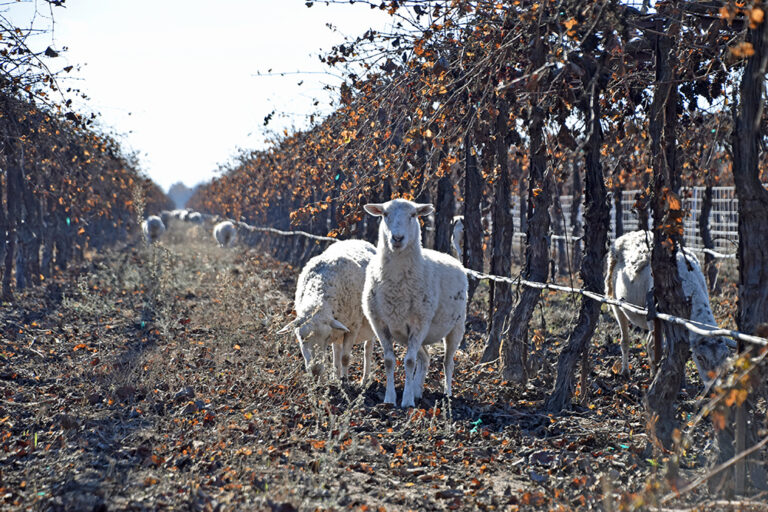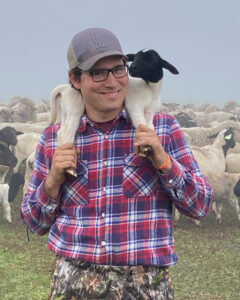
An increasing number of winegrape growers are resurrecting an age-old practice of grazing sheep in vineyards to manage weeds, improve soil health, recycle nutrients and potentially reduce costs.
As with any new system, adding sheep comes with its own set of challenges. But many adopters say most issues are easily addressed and don’t discourage them from the practice.
Tommy Fenster, a UC Davis doctoral student, is trying to quantify how integrating sheep and other regenerative practices affect 45 selected vineyards from Lodi to the North Coast. Half are using livestock, while the other half are using conventional weed control and management.
At the end of his research, Fenster said he hoped to develop best management practices for grazing vineyards, incorporating what he found as well as knowledge from producers in Europe and New Zealand. Included will be an economic analysis related to hiring contract grazers.
Fenster’s project also is part of the much larger Ecdysis Foundation 1000 Farms Initiative, a two-year effort to research regenerative farming systems nationwide.
Working with Nature
Since Paicines Ranch was founded in 1846 near Paicines, Calif., cattle and more recently sheep have grazed the hillsides. Beginning in 2001, ranch managers moved to a more holistic approach that used regenerative practices to try to return the exotic annual grasslands to native grasses.
When ranch owner Sallie Calhoun decided to plant a 25-acre vineyard beginning in 2017, she wanted to take a similar path.
“It’s flipping this whole idea of controlling nature and instead working with nature,” said Kelly Mulville, director of wine growing for Paicines Ranches. One of the operation’s goals is to increase biodiversity while remaining profitable.
Winegrapes are not new to the ranch, with it hosting what was at the time the world’s largest varietal vineyard in the 1960s through the 1990s.
Mulville described their latest vineyard endeavor as more of a large-scale experiment that includes 17 different varietals. They looked globally for varieties that would thrive under similar hot, dry climatic conditions as those found near Paicines.

They planted the first 12.5 acres in 2017, hoping to take what they learned and apply it to the second planting of 12 acres in 2000. Mulville said he also sought a trellis design that would allow sheep to be grazed year-round in harmony with the vines.
Texas viticulturist Jerry Watson had developed a trellis system that improved airflow to reduce mildew under humid Texas conditions. But it also elevated cordons to 66 inches, high enough off the vineyard floor to protect fruit from sheep grazing, Mulville said.
At the same time, the trellis design allows sheep to nibble on low-hanging parts of the canopy and provide shoot tipping and suckering. The drip lines are hung just below the cordons. A V-shaped split at the trellis top creates two fruiting walls, allowing leaves to catch more sunlight while partially shading fruit.
“You’re getting more fruit per vine this way, and the quality is very high,” Mulville said, noting a Grenache yield of 5 tons per acre in their third harvest. “We have a rather long wait list for our fruit.”
Mulville planted the vineyard using 6-by-12-foot spacing, about half the vines of a traditional VSP vineyard. The additional spacing not only reduced planting costs but also made it easier for sheep and hand harvest crews to move between rows.
They chose hair sheep because they are hardier than wool breeds and have a wider pallete when it comes to vegetation. Of the 2,000- to 4,000-sheep flock on the ranch, Mulville said they run a portion in the vineyard for short periods based on the growth rate and recovery of the vegetation. By using sheep, they’ve significantly reduced tractor passes to just nine or 10 per season for fungicide sprays and applying and removing bird netting. The sheep also act as nutrient recyclers, eating vegetation and turning it into manure or urine.
“Sheep or any type of animal are not actually producing nutrients; they’re cycling them so they can only produce what they’re taking in off the ground,” Mulville said. “The really important thing with livestock in general is that they’re taking that material, that N, P and K, and they’re making them more available through fermentation in the stomach.”
The urine, in particular, is a good source of nitrogen and potassium and was one reason why Mulville said they chose to set up the vineyard to allow year-round grazing.
Already, he has seen a 5-point Brix increase in their sap analysis, which is an indication of healthy vines. Mulville also noted soil carbon levels had risen by nearly 2%. That equates to about twice the soil moisture holding capacity as it was before they started. During last year’s record rains, he said they saw no runoff.
In addition, Mulville said they’ve documented more than 60 bird species and more than 100 species of plants, most of which were not introduced to the vineyard. Before they planted, they had only found 11 plant species.
Grazing Benefits Organic, Conventional Alike
Vino Farms began looking at sheep for weed control when it began converting some of its vineyards to organic in 2018, said Daniel Meyers, Vino Farms viticulturist in Lodi, Calif.
“When you go organic, you essentially have very few options for weed control,” he said. “It’s just a great way when you go organic to graze everything.”
Their goal was to replace mowers used to reduce vegetation so drill-seeded cover crops would have an easier time getting established. In the process, Meyers said, they found sheep also were good for late-winter or early spring cleanup.
In vineyards with resident vegetation in the middles, the sheep help lower it to reduce frost risk, eliminating another mower pass.
The system worked so well that Vino Farms expanded sheep grazing to conventional vineyards, particularly those in the Delta where the high water table keeps grasses green year-round.
Grazing conventional vineyards also enhances preemergent herbicide activity by removing excess plant matter and improving soil contact.
Altogether, they’re currently using sheep on about 2,000 acres in the northern San Joaquin Valley and Delta because of its cost-effectiveness, Meyers said.
Vino Farms chose to contact for grazing services with Frankie Arburua III, owner of Lodi-based F Ewe Sheep Co. Based on his experience, Meyers said shepherds in the Lodi area charge between $20 and $60 per acre, depending on the acres growers can commit.
As part of the contract with F Ewe Sheep, someone cares for the animals, moves portable electrical fences and transports them among ranches. What makes the arrangement successful is good communication between the parties, Meyers said.
A vineyard, for example, must have a fair amount of vegetation to make it worthwhile for the herder to bring in animals.
“It has to be pretty messy,” he said. If in doubt, Meyers will take a vineyard photo and send it to Arburua for his opinion.
In early spring when they’re applying fungicides, Meyers keeps Arburua in the loop so he can move animals “and he’s ahead of it.”
“It’s really important to have someone you can trust. It just makes it very easy,” Meyers said.
As older vineyards are removed and replanted, he said they likely will move to a single high-wire trellis system that allows for full mechanization of cultural practices. Having the cordons higher off the ground also lends itself to grazing for a much longer part of the season.
Because Vino Farms doesn’t have the facilities or space to maintain their own sheep, he said they plan to continue contracting for grazing services.
Sheep for Rent
And it’s for just that reason that Arburua, a fourth-generation sheep rancher, said he has seen his contract grazing business grow substantially the past few years. In 2021, he conducted a sheep grazing field with the Lodi Winegrape Commission on the 18-acre Schulenberg Vineyard. The vineyard is certified sustainable under Lodi Rules.
“Ever since then, it’s grown from doing 20 acres,” Arburua said.
This season, Arburua has 700 to 800 ewes, not counting lambs they produce, and estimates he’ll graze about 2,000 acres. Eventually, he’d like to build up to about 1,500 ewes.
His brother, Vince, has a separate contract grazing business, VA Livestock, with about 700 to 800 sheep.
Frankie Arburua uses hair sheep because they’re hardier, less prone to hoof rot, have lower nutritional requirements and don’t require sheering like wool sheep do.
How long the sheep are left in a vineyard depends on location, vegetation and the grower’s goals. Arburua said he also weighs the number of animals with the size of the fenced-off paddocks to minimize potential compaction.
The vineyard grazing season typically ends after budbreak in April. But Arburua is exploring how to extend the season and worked with a Linden-area walnut producer in 2023 to run sheep in orchards after grapes. He said the orchards could be grazed for much of the season were it not for food safety rules, which require animals be removed 120 days before harvest. Grapes destined for wine production don’t fall under those rules because fermentation with accompanying alcohol production is considered a pathogen kill step.











